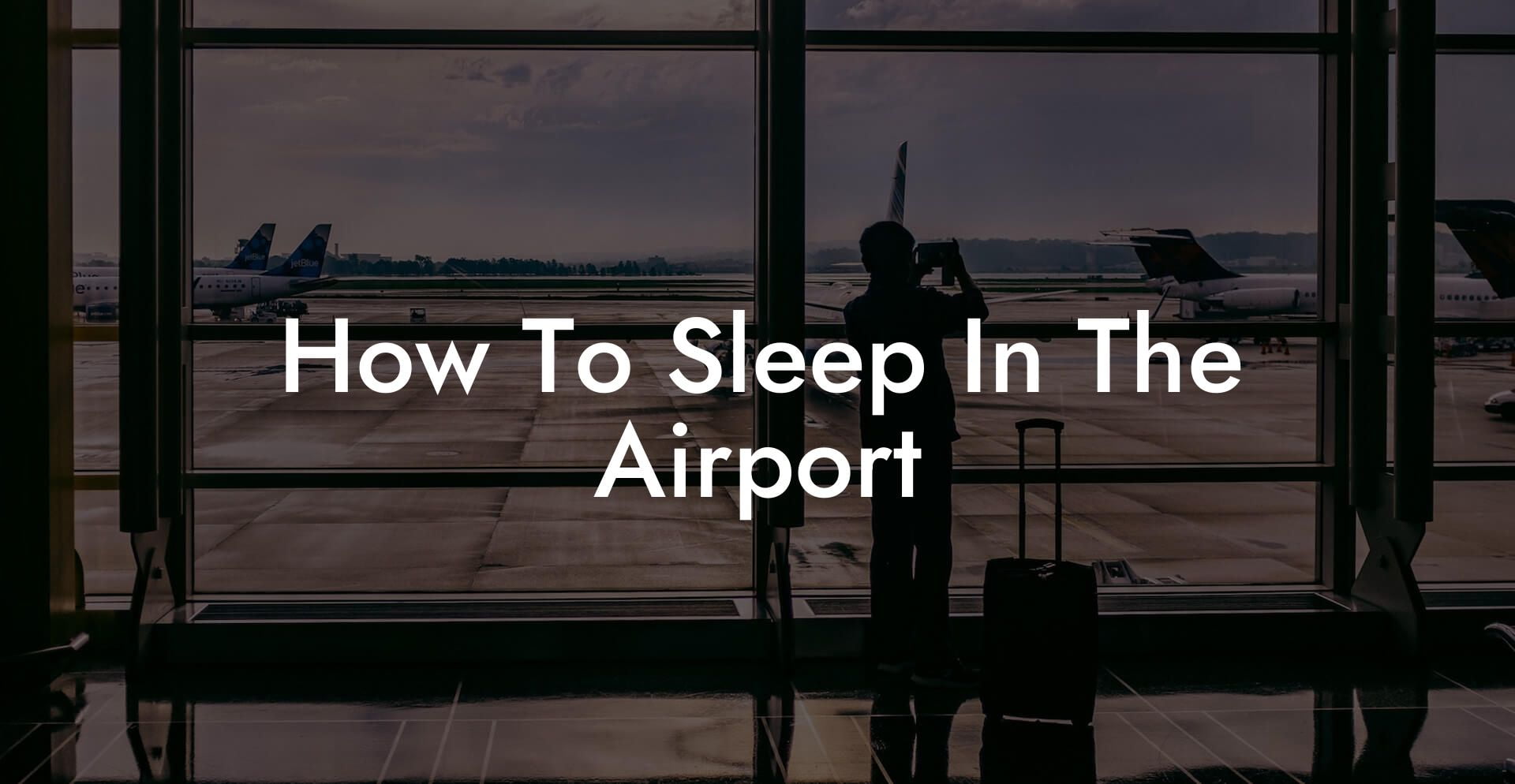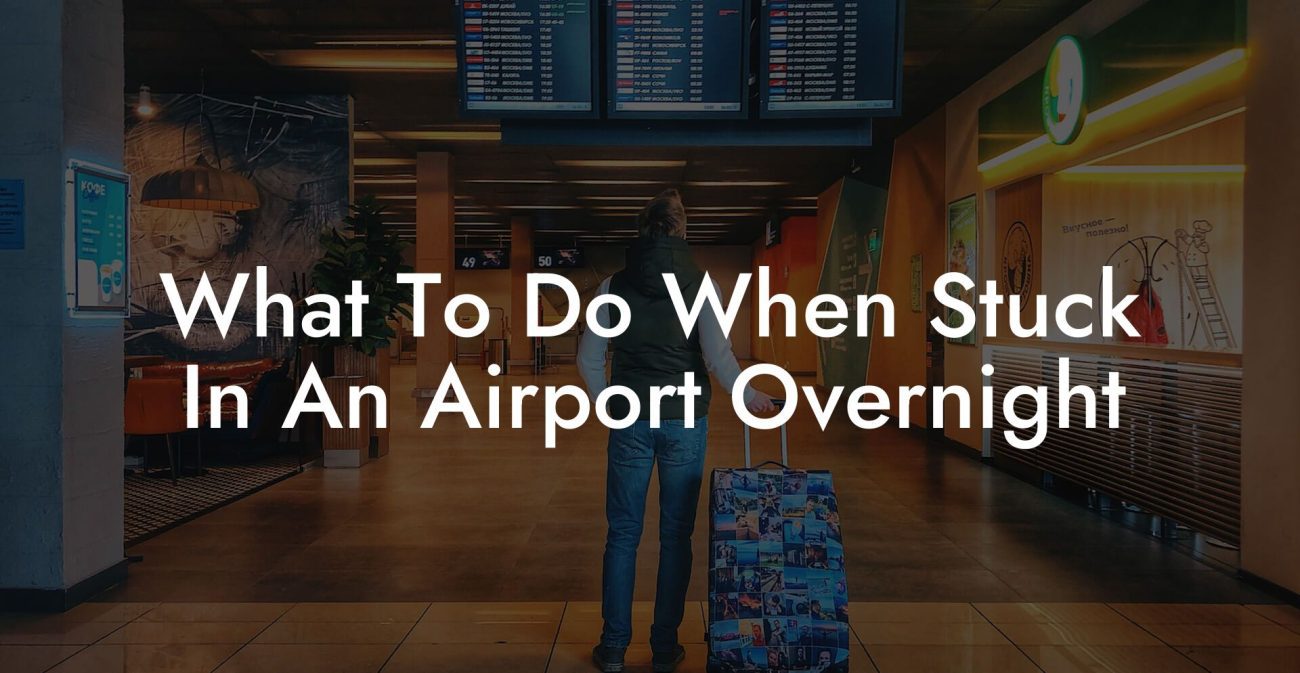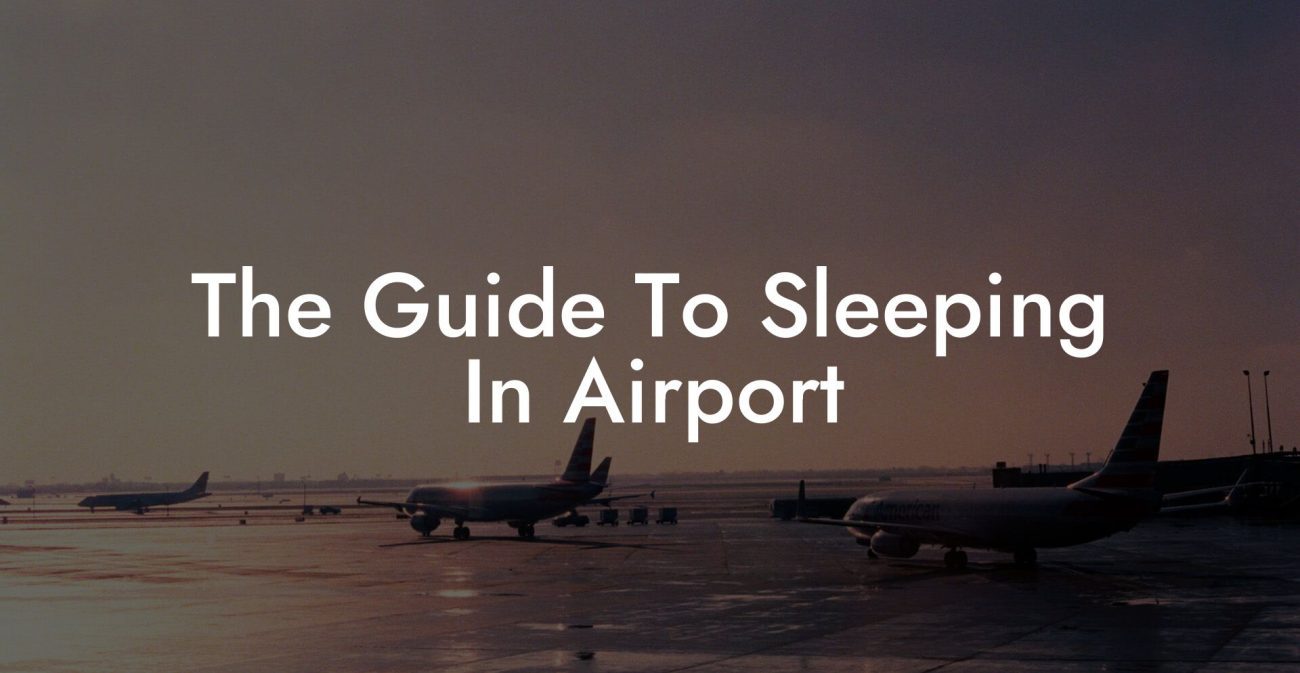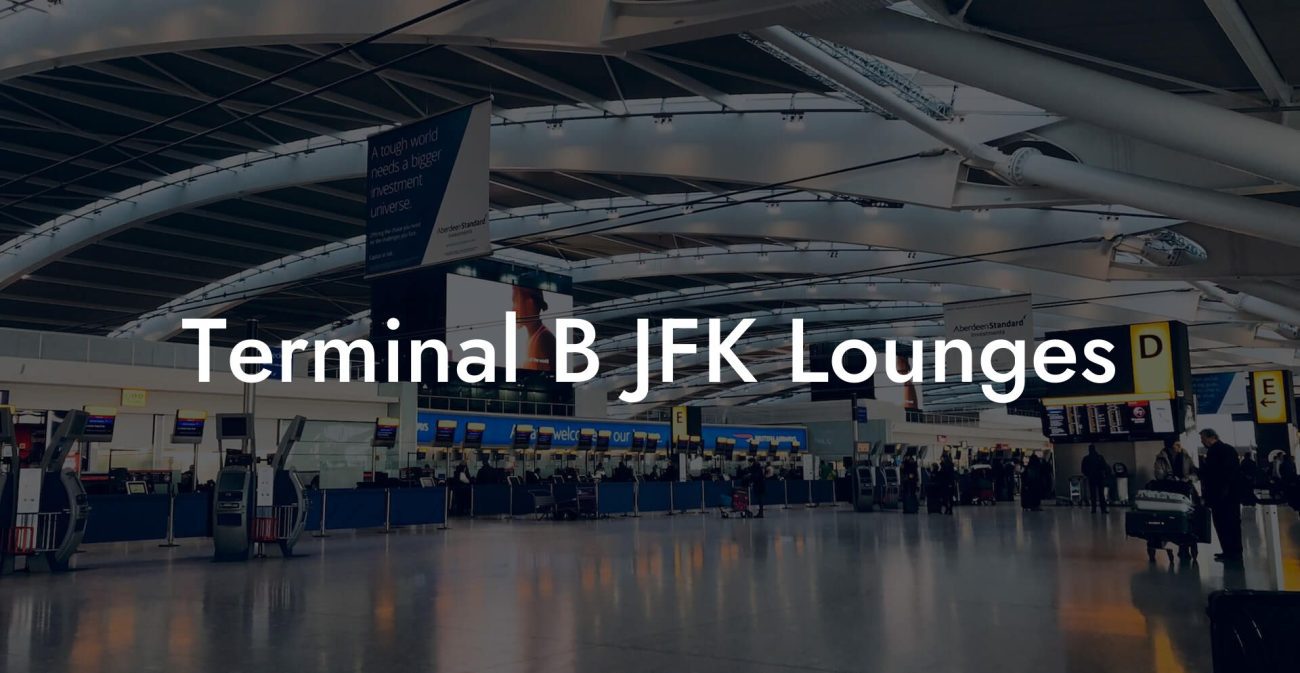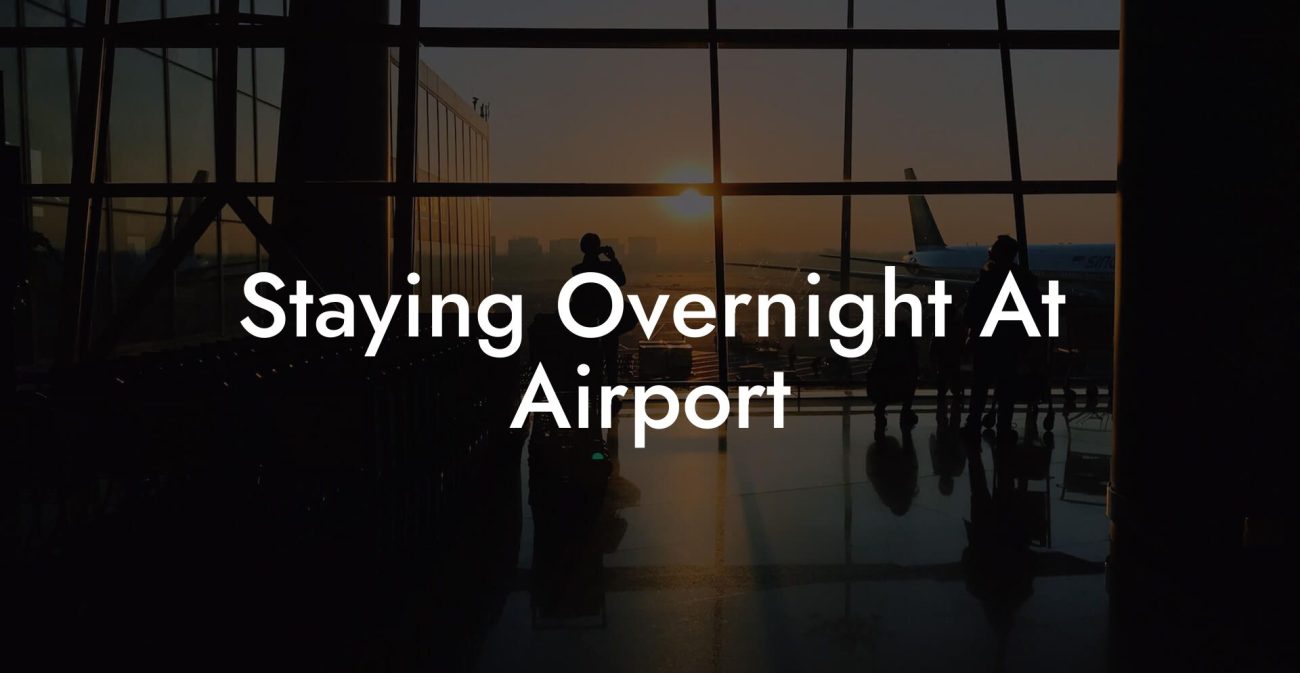Ever found yourself battling jet lag, a delayed flight, and a budget that screams “no hotel tonight,” only to realize that the airport terminal might become your unexpected sleeping sanctuary? If your travel adventures have ever led you to a terminal that feels less like a pit stop and more like a makeshift bedroom, you’re in the right place. Dive into this bold, no-holds-barred guide on how to sleep in the airport, where hustling meets chill and travel hacks transform even the busiest terminals into your personal nap haven.
Quick Links to Useful Sections
- Why You Might Need to Sleep in an Airport
- The Reality of Airport Sleeping: Setting the Stage
- Pros and Cons of Catching Z’s at the Airport
- Finding the Perfect Spot: Airport Sleeping Zones and Hidden Gems
- How to Prepare for an Airport Sleepover: Your Ultimate Checklist
- 1. Pack Smart
- 2. Dress for Comfort
- 3. Stay Charged and Connected
- 4. Keep Your Belongings Safe
- 5. Plan for Hygiene
- The Rise of airport sleeping pods: A Glimpse into the Future of Travel
- Top Travel Hacks to Maximize Your Airport Sleep Experience
- Airport Sleeping Etiquette: Do’s and Don’ts for the Savvy Traveler
- Do’s
- Don’ts
- Creative Solutions for a Better Airport Sleep
- Maximizing Comfort with Technology and Travel Apps
- Safety and Security: Sleeping Like a Pro in a Public Space
- Resources and Community Support: Your Next Steps
- Frequently Asked Questions About Airport Sleeping
- The Final Word on Airport Sleep: Turn Layovers into Power-Ups
Why You Might Need to Sleep in an Airport
Let’s be real: airport sleep isn’t always a lifestyle choice—it’s an emergency backup plan when your flight is delayed, your budget is tight, or you simply can’t find a decent hotel before that red-eye flight. From last-minute cancellations to marathon layovers, sometimes the airport becomes your only option. And while the thought of snoozing on a cold, hard bench might seem daunting, a little planning and a dash of humor can turn this challenge into a surprisingly comfortable pit stop on your journey.
For the Gen-Z and millennial travelers out there, airports are no longer just transit points—they’re vibrant hubs of fleeting connections, quirky art installations, and yes, even innovative sleeping pods. With every delayed boarding announcement, there’s an opportunity to embrace unexpected downtime, recharge your body and spirit before the next leg of your adventure.
So, if you’ve ever experienced the agony of zigzagging between terminals or had a layover that stretched into an impromptu overnight stay, you’ll soon discover that mastering the art of airport sleep isn’t rocket science—it’s all about strategy, a bit of tech-savvy, and a healthy attitude toward unexpected travel quirks.
The Reality of Airport Sleeping: Setting the Stage
Picture this: you’re wandering through a bustling terminal with rows of duty-free shops, neon signs, and non-stop announcements. You spot an empty nook, a bench tucked away behind a row of shops, or even a state-of-the-art sleeping pod that promises a cozy retreat from the chaos. Whether you choose the hustle of a common area or the privacy of a designated sleep zone, your mission is simple: claim your space, block out the noise, and drift off like the savvy traveler you are.
But here’s the catch—sleeping in an airport isn’t just about finding a spot to lay your head; it’s about balancing safety, comfort, and a bit of etiquette. We’re talking about turning mild inconveniences into full-fledged travel hacks that redefine your layover experience. Ready to learn the secrets? Read on.
Pros and Cons of Catching Z’s at the Airport
Every silver lining comes with a cloud (and sometimes, a blinking boarding gate). Here’s a no-nonsense breakdown of the advantages and challenges of airport sleeping:
-
Pros:
- Cost-effective: Say goodbye to expensive hotel bills and hello to more cash for your next adventure.
- Convenience: No need to book additional transit—if you’re already at the airport, why not stay right there?
- Flexibility: With many sleeping options (from comfy seating to futuristic sleeping pods), you can tailor your experience to your needs.
- No Check-In Hassles: Avoid the stress of hotel check-ins or unfamiliar room service menus.
-
Cons:
- Noise and Light: Terminals are rarely quiet, so come prepared for blinking screens and intermittent announcements.
- Hygiene: Cleanliness levels vary, so you may need to bring your own blanket or sanitizing wipes.
- Security Concerns: Always be mindful of your belongings in a public space, and choose spots that balance convenience with safety.
- Comfort: Not every bench is created equal—some will have more legroom and fewer intrusive travelers than others.
While the idea of sleeping in the airport might evoke images of hard benches and endless security footage, with a bit of foresight and some savvy hacks, you can transform any terminal into a temporary haven.
Finding the Perfect Spot: Airport Sleeping Zones and Hidden Gems
The quest for the ideal airport sleep spot reads like an urban treasure hunt. Airports are designed for transit, not tranquility—but many terminals are now embracing comfort as part of the travel experience. Look for:
- Designated Rest Zones: Increasingly, airports are dedicating quiet areas for napping and relaxation. These areas might feature reclining chairs, soft lighting, and even charging ports for your devices.
- Sleeping Pods: Tech-savvy airports are rolling out futuristic sleeping pods that look like mini hotel rooms. They’re equipped with comfortable beds, privacy screens, and soundproofing to block out the madness.
- Lounges: Even if you’re not a frequent flyer, consider treating yourself to a day pass in an airport lounge. They offer plush seating, complimentary snacks, and a quieter environment that’s perfect for a quick snooze.
- Secluded Corners: If you’re on a tight budget, scout for hidden corners, unused gates, or less-trafficked areas where you can set up your portable comfort zone.
Pro tip: Use apps and travel blogs to scout out the best airport sleeping spots before you travel. Many fellow travelers share insider tips on exactly where to avoid bright, bustling terminals and where you can find that rare slice of calm.
How to Prepare for an Airport Sleepover: Your Ultimate Checklist
Preparation is key to turning a potentially rough night at the airport into a rejuvenating pit stop. Here’s your ultimate checklist to ensure you’re ready for any terminal-induced sleep extravaganza:
1. Pack Smart
Your carry-on should be a mini survival kit. Essentials include an eye mask to block out harsh lighting, a pair of earplugs or noise-cancelling headphones to tame the ambient chaos, and a travel pillow for neck support. Don’t forget a lightweight, compact blanket or a shawl that can double as extra cushioning.
2. Dress for Comfort
Airport temperatures can be unpredictable, so layer up! Soft, breathable fabrics are ideal. Oversized hoodies, leggings, and slip-on shoes can make your travel sleep experience feel more like an impromptu slumber party than a transit nightmare.
3. Stay Charged and Connected
A fully charged phone is your lifeline—whether it’s for your flight updates or as a portable source of entertainment. Pack a power bank, and if possible, scout out charging stations as soon as you land.
4. Keep Your Belongings Safe
Never let your valuables out of sight. Invest in a portable travel safe or a lockable bag, and if you find a quiet corner to sleep, position yourself so that your belongings are within arm’s reach.
5. Plan for Hygiene
A well-stocked hygiene kit can make a world of difference. Pack travel-sized toiletries, hand sanitizer, and antibacterial wipes. If you plan on sleeping in a public area, a quick freshen-up can turn a rough terminal into a spa-like retreat.
With this checklist in your arsenal, you’re not just prepared—you’re a master of airport survival, seamlessly blending resourcefulness with traveler swagger.
The Rise of airport sleeping pods: A Glimpse into the Future of Travel
Remember the days when sleeping in an airport meant crumpled seats and awkward elbow room? Enter the age of airport sleeping pods—a revolutionary solution for the modern wanderer. These high-tech nooks are popping up in airports around the globe, designed to give you a taste of luxury even in the midst of transit madness.
Sleeping pods offer the perfect blend of privacy and convenience. Equipped with soft lighting, adjustable beds, privacy curtains, and even built-in charging ports, they transform the sterile airport environment into a cozy retreat. Some even offer climate control and background
Imagine settling into a pod that feels like your own miniature capsule hotel—an oasis where you can recharge both your battery and your body before embarking on the next leg of your journey. While not every airport has embraced these futuristic pods just yet, it’s a trend that’s quickly gaining momentum. Keep an eye out for them on your next trip, and you might just find that waiting for your flight turns into a surprisingly luxurious experience.
Top Travel Hacks to Maximize Your Airport Sleep Experience
If you’re the type of traveler who sees every inconvenience as a puzzle waiting to be solved, then these travel hacks are your ticket to a smooth, restful airport sleep:
- Scout Ahead: Use airport maps and traveler forums to pinpoint sleeping zones and charge-up stations as soon as you enter the terminal.
- Time It Right: Try to sleep during off-peak hours. The quieter early-morning hours or late-night windows usually yield a more restful environment.
- Embrace the Art of Layering: Airports can be AC-cold or sweltering hot. Packing layers lets you adjust your comfort level on the go.
- Pre-order a Lounge Pass: Some airports offer day passes for their lounges. Sometimes spending a few extra bucks can lead to a significantly superior sleep experience complete with comfy seats, food, and Wi-Fi.
- Book a Sleep App: There are travel apps that provide insights into the quietest terminals, user-submitted reviews on sleeping conditions, and real-time runway noise alerts.
With these hacks in your travel toolkit, you won’t just survive an airport overnight— you’ll thrive in it, making even the longest layovers a part of your epic travel story.
Airport Sleeping Etiquette: Do’s and Don’ts for the Savvy Traveler
Sleeping in a public space calls for a bit of etiquette to ensure you’re not only comfortable but also respectful of your fellow travelers. Let’s lay out some golden rules for the airport sleep scene:
Do’s
- Keep It Low-Key: Use earphones to set the mood with your favorite relaxation playlist, and avoid talking loudly on your phone.
- Stay Alert: Even if you’re catching some z’s, keep an eye on your belongings. A folded jacket over your lap or a travel lock can be your best friend.
- Be Mindful of Others: Choose a spot that doesn’t block walkways or access to essential facilities like restrooms and charging stations.
Don’ts
- Don’t Hog the Space: If you’re settling in for a nap on a bench or floor, try not to spread your belongings too far. Save some room for the next weary traveler.
- Avoid Outright Sleepwalking: It sounds funny, but be aware of your surroundings. An awkward attempt to navigate a new terminal while half-asleep can lead to some embarrassing encounters.
- Don’t Snore Your Way to Fame: A snoring symphony might be the last thing on your fellow travelers’ wish lists. If you can’t help yourself, at least try to adjust your position discreetly.
Following these simple do’s and don’ts ensures that your airport sleep remains a private, restorative moment—and a positive experience for everyone around you.
Creative Solutions for a Better Airport Sleep
Sometimes, creativity is your best travel companion. When standard sleeping zones aren’t cutting it, why not get inventive? Here are a few ideas to elevate your airport nap game:
- DIY Privacy: Use a scarf or a lightweight curtain from an airport gift shop to create your own mini sleep cocoon where you can snooze without prying eyes.
- Travel Yoga: Do a few gentle stretches or yoga poses (think seated forward bends or neck rolls) to relax your muscles before lying down. It’s a great way to destress and prepare your body for sleep.
- Portable White Noise: If you have a small speaker or even a white noise app on your phone, use it to drown out sporadic terminal noises.
- Book a Lounge Upgrade: Sometimes, spending a little extra on a comfortable seat in a premium waiting area can be a game-changer when your flight schedule is anything but predictable.
Innovation and flexibility are the secret ingredients to transforming a lackluster layover into a rejuvenating experience. Whether you’re crafting your own mock privacy nook or leveraging modern sleep pods, remember: creativity is your passport to comfort.
Maximizing Comfort with Technology and Travel Apps
In the digital age, your smartphone is more than just a communication device—it’s a travel assistant, a sleep monitor, and sometimes even a lullaby machine. Technology can play a huge role in optimizing your airport sleep:
- Sleep Tracker Apps: Monitor your nap durations and sleep quality with apps that help you determine the best time to snooze. Knowing when you’re in the deep-sleep phase can help you plan your wake-up to avoid grogginess.
- Travel Forums & Reviews: Platforms like TripAdvisor, Reddit’s r/travel, and dedicated airport apps provide real-time reviews and tips from fellow travelers about the best sleeping spots in even the busiest terminals.
- Noise Machine Apps: If you’re without earplugs, many noise machine apps simulate ambient sounds ranging from white noise to soft rain, which can mask disruptive terminal sounds.
- Navigation & Terminal Maps: A digital map of the airport can help guide you to quieter zones, ensuring you avoid busy corridors and find those hidden retreats.
Embracing technology not only improves your comfort but also transforms your overall travel experience. It’s a modern-day survival kit for every globetrotter looking to maximize rest in unconventional spaces.
Safety and Security: Sleeping Like a Pro in a Public Space
As much as sleeping in the airport is about comfort, it’s equally about safety. You’re in a public area, and while most travelers are friendly, it’s important to look out for yourself:
- Scout for Security: Choose well-lit, high-traffic areas that offer both a sense of security and minimal isolation while you sleep.
- Keep Essentials Close: Your wallet, passport, and phone should always be within arm’s reach. Consider using a neck pouch or a travel-safe bag that’s hard to snatch.
- Set an Alarm: Whether it’s to remind you when your flight is boarding or just to ensure you don’t oversleep, use a dependable alarm clock app. It’s all about waking up on time—and in the right terminal.
- Blend In: Dress like you belong. The more you look like a seasoned traveler, the less likely you are to draw unwanted attention.
With these simple safety strategies in place, you can sleep soundly knowing you’re as prepared as possible in any airport environment.
Resources and Community Support: Your Next Steps
Whether you’re a first-timer or a seasoned serial sleeper of terminals, there’s a wealth of resources waiting to elevate your airport sleep game. Join travel communities on Reddit, Facebook, or specialized travel blogs that share practical tips, real-time updates on airport facilities, and personal stories that make you feel like part of a global family of intrepid wanderers.
Consider following these steps to deepen your connection with fellow airport aficionados:
- Subscribe to Travel Newsletters: Many travel websites offer newsletters packed with insider tips on which airports are best for catching Z’s, the latest in sleeping pod technology, and hacks to make your layover more comfortable.
- Download Essential Apps: Look for apps that provide real-time updates on flight delays, lounge access, and terminal maps. Community-driven apps can also offer reviews and hidden gems from travelers just like you.
- Engage on Social Media: Platforms like Instagram and Twitter are teeming with travel influencers sharing snapshots and stories of airport naps that defy expectations. Follow hashtags such as #AirportSleep, #TravelHacks, or #TerminalNap for daily inspiration.
- Join Local Meetups: For the digital nomad or frequent flyer, local travel clubs or meetups are great places to exchange stories, tips, and even carpool to out-of-the-way airports that offer exceptional layover experiences.
Your next step in the airport sleep revolution is connecting with a community that celebrates the art of catching Z’s in the most unexpected places. Share your tips, swap stories, and become a part of a network that not only survives, but thrives, on the challenges of modern travel.
Frequently Asked Questions About Airport Sleeping
Here are some of the most common questions travelers ask about sleeping in airports, and the answers to help you sleep like a champ—even amidst the chaos.
1. Is it safe to sleep in an airport?
Yes, as long as you choose well-lit, populated areas and keep your belongings secure. Most airports have security personnel around, but it’s always best to stay alert.
2. How can I make an airport bench more comfortable?
A travel pillow, a lightweight blanket or shawl, and a little creative use of your carry-on items can go a long way toward transforming a hard bench into a temporary nap zone. Try to find a spot with armrests or a slight incline for added comfort.
3. Are airport sleeping pods worth it?
For many frequent flyers, yes. Sleeping pods often offer privacy, a comfortable sleeping surface, and perks like charging ports and quiet environments. If your airport has them and your budget allows, they can make a significant difference.
4. What if my flight gets delayed while I’m sleeping?
Set at least one alarm to wake you on time, and keep an eye on flight updates through airline apps or airport monitors. Planning ahead helps ensure you’re up and ready when it’s time to board.
5. Can I use airport lounges for sleeping if I’m not a frequent flyer?
Absolutely! Many lounges offer day passes that provide a more comfortable, quiet space to relax and even catch a nap. It might cost a bit extra, but the added comfort and amenities can be well worth it.
The Final Word on Airport Sleep: Turn Layovers into Power-Ups
Sleeping in an airport might not be the luxurious retreat you daydreamed about, but it can be an unexpectedly empowering experience. With a blend of creative hacks, a well-prepared travel kit, and a positive mindset, those long layovers can transform into rejuvenating power-ups for your next adventure.
From futuristic sleeping pods to hidden quiet corners and digital travel hacks, this guide is your passport to mastering the art of airport sleep. Next time you face the challenge of an overnight layover or a delayed flight, remember this guide—and rest easy knowing that every terminal holds the promise of a brief, well-deserved escape from the chaos.
So, embrace the unexpected, learn to adapt, and let your journey be defined not by the chaos of travel delays but by the smart, inventive ways you recharge on the go. Your next airport sleep experience is not just about surviving—it’s about thriving.
Useful Interruption: Dive deeper into the world of airport sleeping guides with our most popular sections. If there is anything you think is missing or anything you would love for us to write about, just give us a shout.
- General Airport Sleeping Guides
- Travel Gear & Equipment Recommendations
- Regional and Airport-Specific Guides
- Airport Sleeping Pods & Reviews
- Health, Safety, and Comfort Tips for Airport Sleepers
Last week, I decided to try the world-famous "airport sleepover" experience. Imagine this: I'm lying on a bench in Terminal C, surrounded by suitcases that have seen more of the world than I ever will, and a PA system that sounds like a karaoke machine on a sugar rush. I pull out my travel pillow—which, by the way, is more like a sad deflated balloon—and declare, "Tonight, I’m the king of this terminal!"
Soon enough, fellow travelers become my unexpected audience. One guy, fresh off a red-eye, whispers, "Hey, do you think if we sleep long enough, we can catch our flight in our dreams?" I reply, "Sure, and maybe I'll even get an upgrade to first-class in my nap!" The airport lights flicker like a disco ball, and every time someone announces a delayed departure, it’s like a punchline to our impromptu stand-up routine.
As I finally drift off, I dream of a world where boarding passes are like VIP tickets to the best sleepover party ever—a party where the only baggage is the laughter you carry with you. Waking up, I realize the airport is still the same, but I now hold the honorary title of "Terminal Comedian," a title I wear with as much pride as my permanently mismatched socks!

